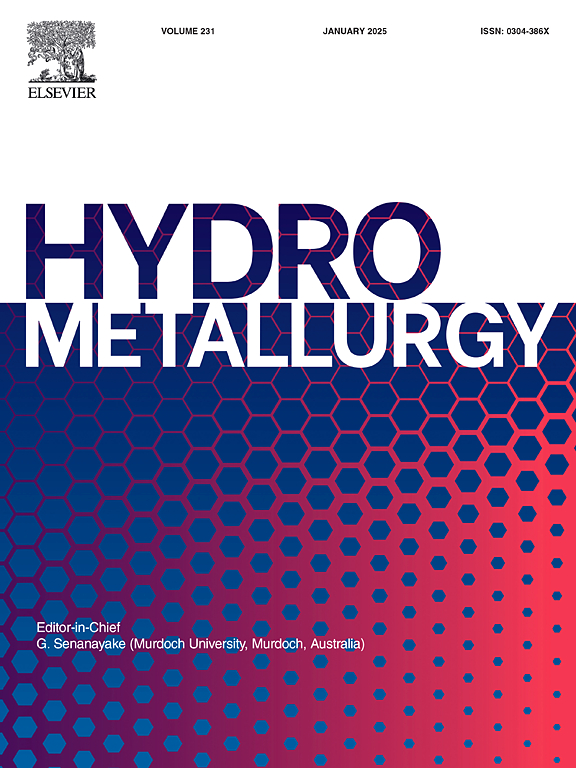Thermodynamic modelling of the Li-Na-K-OH-SO4-H2O system for lithium hydroxide production simulation
IF 4.8
2区 材料科学
Q1 METALLURGY & METALLURGICAL ENGINEERING
引用次数: 0
Abstract
The caustic addition process to Li2SO4 leachate is a principal industrial process in producing lithium hydroxide. This process relies on the double-decomposition reaction between Li2SO4 and NaOH in an aqueous system, followed by cooling to separate Na2SO4∙10H2O and evaporation to produce LiOH∙H2O. Due to the presence of Na and K impurities in lithium minerals, the operation takes place in the complex aqueous system Li-Na-K-OH-SO4-H2O. This work describes: (i) the development of a thermodynamic model for the complex Li-Na-K-OH-SO4-H2O system, (ii) validation of its reliability and (iii) quantitative simulation of lithium-hydroxide production. The results led to four key conclusions: 1) A relatively low concentration (Li < 20 g/L) in the caustic solution prevents the formation of Li2SO4∙3Na2SO4∙12H2O, the principal source of lithium loss. 2) The optimal cooling temperature for removing Na2SO4∙10H2O is −10 to −15 °C. 3) A moderate evaporation temperature (50–60 °C) is critical for achieving the high recovery of LiOH∙H2O in a single cycle. 4) The mother liquor remaining after the crystallisation of LiOH∙H2O can be fully recycled. Theoretically, Na and K are completely removed as Na2SO4∙10H2O and NaK3(SO4)2 solids.
用于氢氧化锂生产模拟的Li-Na-K-OH-SO4-H2O体系热力学建模
硫酸渗滤液的碱加成工艺是生产氢氧化锂的主要工业工艺。该工艺依赖于水溶液中Li2SO4与NaOH的双重分解反应,然后冷却分离Na2SO4∙10H2O,蒸发生成LiOH∙H2O。由于锂矿物中存在Na和K杂质,该操作在复杂的水体系Li-Na-K-OH-SO4-H2O中进行。这项工作描述了:(i)复杂的Li-Na-K-OH-SO4-H2O体系的热力学模型的发展,(ii)其可靠性的验证和(iii)氢氧化锂生产的定量模拟。结果得出了四个关键结论:1)相对较低的浓度(Li <;在苛性碱溶液中加入20 g/L)可阻止Li2SO4∙3Na2SO4∙12H2O的形成,而Li2SO4∙12H2O是锂损失的主要来源。2)脱除Na2SO4∙10H2O的最佳冷却温度为−10 ~−15℃。3)适度的蒸发温度(50-60℃)是实现LiOH∙H2O单循环高回收率的关键。4) LiOH∙H2O结晶后剩余的母液可充分回收。理论上,Na和K被完全脱除为Na2SO4∙10H2O和NaK3(SO4)2固体。
本文章由计算机程序翻译,如有差异,请以英文原文为准。
求助全文
约1分钟内获得全文
求助全文
来源期刊

Hydrometallurgy
工程技术-冶金工程
CiteScore
9.50
自引率
6.40%
发文量
144
审稿时长
3.4 months
期刊介绍:
Hydrometallurgy aims to compile studies on novel processes, process design, chemistry, modelling, control, economics and interfaces between unit operations, and to provide a forum for discussions on case histories and operational difficulties.
Topics covered include: leaching of metal values by chemical reagents or bacterial action at ambient or elevated pressures and temperatures; separation of solids from leach liquors; removal of impurities and recovery of metal values by precipitation, ion exchange, solvent extraction, gaseous reduction, cementation, electro-winning and electro-refining; pre-treatment of ores by roasting or chemical treatments such as halogenation or reduction; recycling of reagents and treatment of effluents.
 求助内容:
求助内容: 应助结果提醒方式:
应助结果提醒方式:


